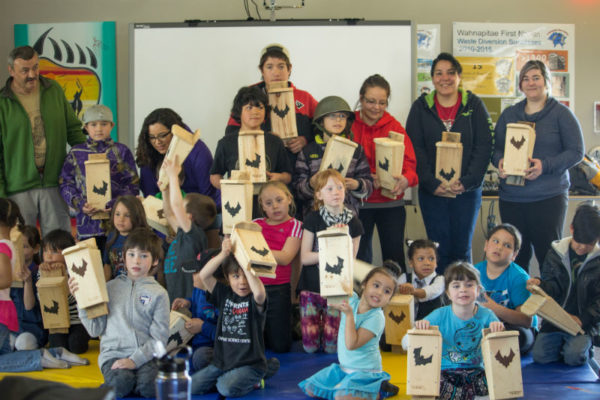A welcome home for bats (x 50)
“When I was a child, bats were everywhere. When we played outside they would fly over us. Now it’s very rare to see them around,” says Stefanie Recollet, a resident of Wahnapitae First Nation in Capreol, near Sudbury, Ont.
So when her community was contacted by Canadian Wildlife Services about species at risk living near the reserve, they immediately made the connection between what they had been seeing and the dramatic decline of bat populations in other parts of the country. “We wanted to do something about it,” Stefanie recalls. They applied for and received a Go Wild Community Grant to bring the community together to build bat boxes to help declining bat populations recover, with Stefanie leading the way.
Across Canada, diminishing bat populations are a serious cause for concern. Seven of 18 species of bats in Canada are listed as at-risk under the federal Species At Risk Act (SARA). The main threats to bats are:
- pesticides and habitat changes that reduce their prey (insects), making it harder to find food;
- habitat loss caused by deforestation;
- habitat loss caused by destruction of breeding cavities and wintering hibernacula (underground cavities, such as caves and mine shafts, where wintering bats hibernate);
- other human disturbances, such as increasing cave exploration;
- and, white-nose fungus
White-nose syndrome has been especially devastating, spreading rapidly through populations of at least three bat species, with some down by as much as 90 per cent. The little brown bat, northern long-eared bat and tri-coloured bat, whose ranges extend to Wahnapitae First Nation, are some of the hardest hit by the disease. All three are listed as endangered due to the sudden and dramatic declines in their populations.
Using the Go Wild Community Grant, Wahnapitae First Nation hosted a “Build a Bat Box Day.” Children, their parents and grandparents turned out to learn from bat expert and biologist Franco Mariotti, who visited the community to spread the word about bats, where to locate bat boxes and how to properly mount them. By the end of the day, 50 new bat boxes had been built.
“Our goal was to bring awareness about declining bat populations and help get rid of harmful myths about bats. We wanted to show how useful and fascinating bats are, and how integral they are to our ecosystems,” Stefanie explains. “We also wanted to address habitat loss by providing safe summer housing for when they come out of hibernation.”
With the new bat boxes in place, Wahnapitae First Nation is now participating in a regional study with other First Nations that have experienced a decline in bats. Over the fall, various communities will monitor house sites for activity, collect information to help assess trends, and then find solutions to bring bat populations back.
While the main purpose of the Build a Bat Box project is to create clean, safe spots for bats, Stefanie believes activities like these remind her people of their responsibilities to nature.
“It’s in our traditions to be stewards of the land. And if given the opportunity, children do take it very seriously; they understand their responsibilities,” she says. Through the community’s superhero program, kids receive capes and pick a superpower that symbolizes their personal responsibility to nature. Whether it’s water, land, trees, bats or something else, they’ll continue to take on projects to protect and conserve the natural world. “Nature is an intrinsic part of who were are,” she says. “We’re meant to live in harmony with the environment.”
How you can help bats
Bats need large-scale conservation interventions that reduce pesticides and protect their habitat. In the meantime, you can install built bat boxes to ensure there are enough ‘homes’ for bats in your area.
Or go a step further: Apply for a Go Wild Community Grant presented by TELUS to bring to life your idea for promoting bat conservation in your community. Winter applications are open now until Sept. 23, 2016.

![Little brown bat. By U.S. Fish and Wildlife Service Headquarters (Healthy little brown bat Uploaded by Dolovis) [CC BY 2.0 (https://creativecommons.org/licenses/by/2.0)], via Wikimedia Commons](https://wwf.ca/wp-content/uploads/2016/08/Healthy_little_brown_bat_6950595524-400x600.jpg)

